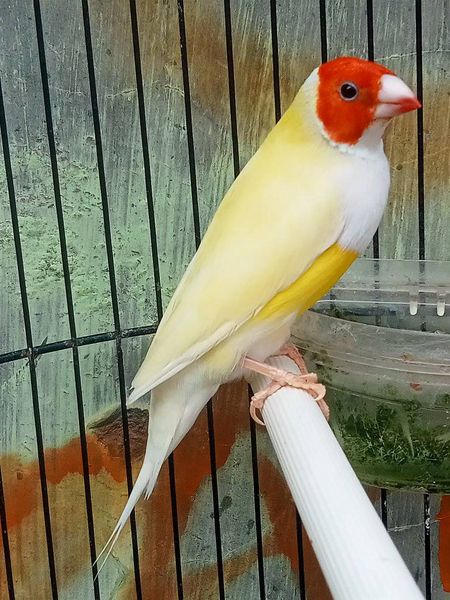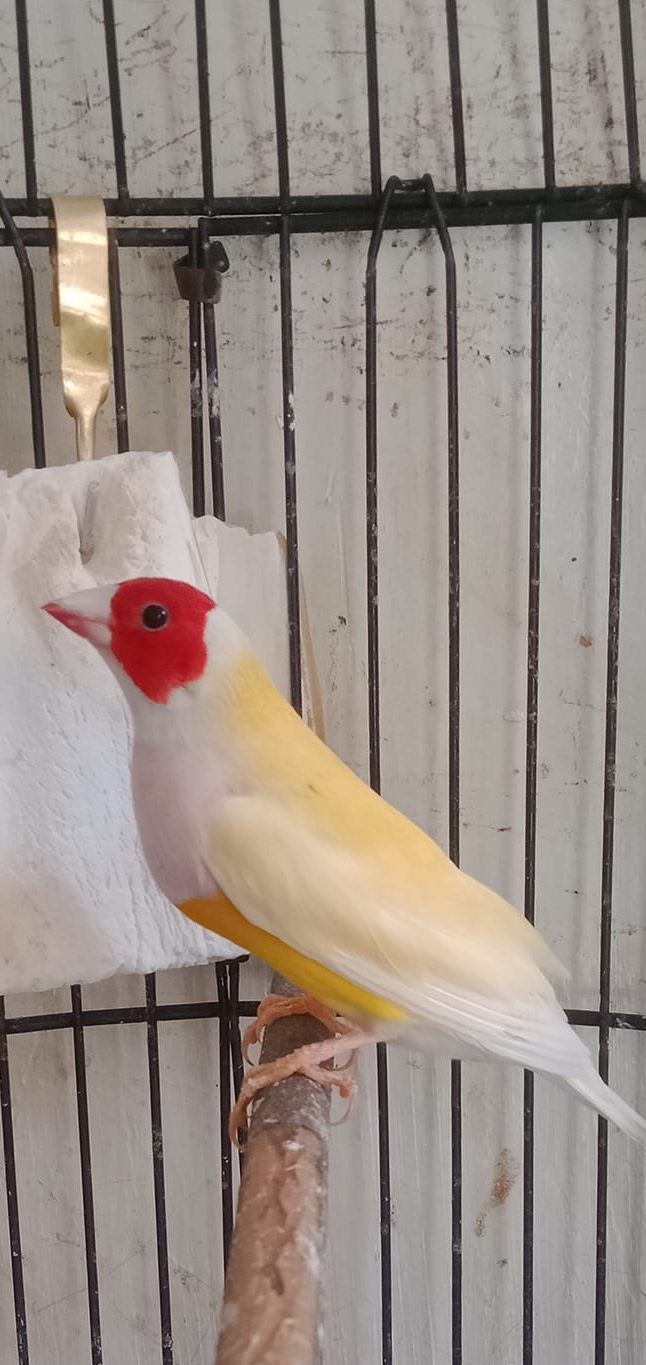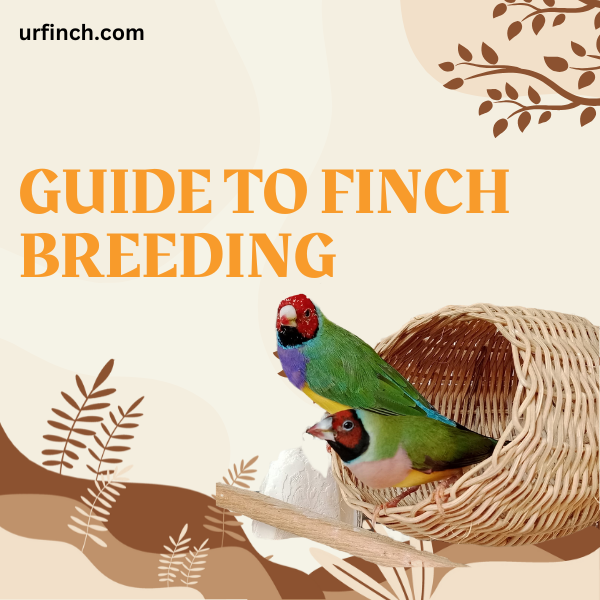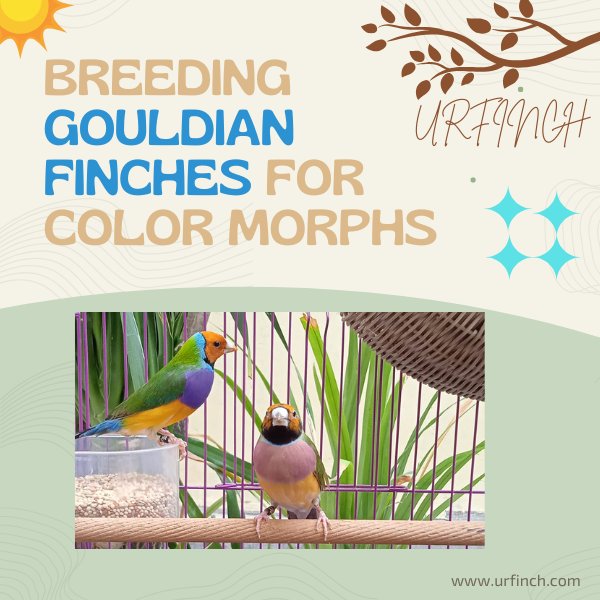Gouldian Finches are often described as one of the most beautiful birds in the world. Known for their vibrant colors and friendly nature, they’ve become a favorite among pet lovers. While these finches are stunning to look at, hand-rearing them takes the experience of owning one to a whole new level. But raising hand-reared Gouldian Finches isn’t just about their beauty—it’s about developing a connection with your bird and ensuring they grow up healthy, happy, and well-socialized.

In this article, we’ll take a deep dive into the world of hand-reared Gouldian Finches, from the basics of hand-feeding to the joys and challenges of raising these amazing birds as pets.
What Are Hand-Reared Gouldian Finches?
Before we get into the details of hand-rearing, it’s important to understand what this term means. Hand-rearing refers to the process of feeding and raising a young bird by hand, instead of allowing it to be cared for by its parents. In the case of Gouldian Finches, this process starts when the chicks are only a few days old and continues until they are ready to leave the nest and eat independently.
Hand-rearing is typically done by breeders or bird enthusiasts who want to raise birds that are particularly tame, social, and used to human interaction. For pet lovers, this is a perfect option if you’re looking for a bird that will bond closely with you. Hand-reared Gouldian Finches are typically more comfortable around people, making them ideal companions for those who want a feathered friend that isn’t afraid of interaction.
Why Choose Hand-Reared Gouldian Finches?

Many pet owners gravitate towards hand-reared Gouldian Finches for several reasons. While Gouldian Finches are beautiful birds, hand-reared ones come with their own set of benefits:
- Bonding with Humans: Hand-reared birds are raised with constant human contact. This allows them to form stronger bonds with people. Unlike wild-caught or parent-raised birds that may be more timid, hand-reared finches will generally feel more comfortable around you and other family members.
- Friendly and Tame: Because they’re raised with human interaction, hand-reared finches tend to be more sociable. They will often enjoy spending time with their human caregivers and may even learn to perch on your finger or shoulder. Over time, they’ll trust you, which can make them delightful companions.
- Easier to Train: Hand-reared birds are often easier to train. They tend to become more attuned to their owners and are more likely to mimic sounds, engage with toys, and respond positively to training.
- Ideal for First-Time Bird Owners: If you’re a first-time bird owner, a hand-reared Gouldian Finch can be a great choice. These finches are small, manageable in size, and don’t require as much attention as some larger bird species, like parrots. Hand-reared Gouldians are also more likely to be calm and approachable, making the whole experience more rewarding for new pet owners.
The Process of Hand-Rearing Gouldian Finches
Hand-rearing a bird, especially a delicate species like the Gouldian Finch, is no small task. It requires time, patience, and a deep understanding of avian needs. Here’s an overview of what’s involved in hand-rearing these stunning finches.
1. Getting Started with Hand-Feeding
When Gouldian Finch chicks are first hatched, they are totally dependent on their parents for warmth and food. Hand-rearing begins after the chicks are a few days old, typically when the parents are either unable or unwilling to care for them. At this point, the chicks are still in their nestling stage and rely on a special formula (similar to baby bird food) that needs to be fed through a syringe or small spoon.
- Feeding Frequency: In the first few days, hand-feeding should be done every 2 to 3 hours, including at night. As the chicks grow, the frequency decreases to about every 4 hours during the day. The formula should be kept at the right temperature—around 105°F (40°C)—and should be fed gently to avoid aspiration (food going into the lungs).
- Proper Formula: It’s crucial to use a high-quality hand-feeding formula specifically designed for small finches or soft-billed birds. These formulas are nutritionally balanced to support growth. Avoid feeding them regular milk or baby food meant for human infants, as these can be harmful to birds.
- Consistency: It’s important to feed them at regular intervals, as consistency helps their digestive system develop properly. Skipping feedings or offering food at irregular times can lead to malnutrition or stunted growth.
2. Weaning and Gradual Introduction to Solid Foods
As the chicks grow older, they’ll start showing signs that they’re ready to transition to solid foods. This is usually around the age of 4 to 6 weeks, but it varies depending on the bird’s development.
- Soft Foods: Start by offering soft foods like soaked seeds, small pieces of fruits and vegetables (like spinach, apple, and carrot), and commercial bird pellets designed for finches. Gradually decrease the hand-feeding while encouraging the chick to eat on its own.
- Monitor Progress: It’s essential to monitor the chick’s eating habits during this transition period. You should continue to provide hand-feeding, but also offer a variety of foods to encourage independence. A chick that’s not eating enough on its own might need more hand-feedings until it is fully weaned.
3. Socialization and Interaction
One of the most critical aspects of hand-rearing is socialization. Because you’re acting as the chick’s primary caregiver, it will grow used to your presence. Spending time with your hand-reared Gouldian Finch is essential for it to develop positive associations with humans.
- Handle with Care: As the chick grows, gently handle it during its awake periods. Start with short, calm sessions where you allow the bird to perch on your hand. You can also try feeding it from your finger or allow it to sit on your shoulder. These interactions help strengthen the bond between you and the bird.
- Talk and Play: Talk to the bird in a calm and soothing voice, as hearing human voices helps the bird become accustomed to human sounds. Play with safe toys like mirrors, bells, and swings to encourage mental stimulation and help it develop coordination.
- Positive Reinforcement: Use positive reinforcement when the bird engages in good behavior. For example, if it hops onto your hand, reward it with a small treat or a stroke. This helps the bird associate you with good things and encourages it to trust you.
4. Health and Hygiene
Hand-reared finches require more attention to their health and hygiene compared to those raised by their parents. Keep their living environment clean and make sure they have access to fresh water and a clean cage.
- Cage Setup: Provide a spacious cage with plenty of perches, food bowls, and toys. The bars should be narrow enough that the chick cannot squeeze through them. It’s also important to clean the cage regularly to prevent any buildup of waste or bacteria that could lead to infections.
- Health Checks: Watch for signs of illness such as lethargy, lack of appetite, or abnormal droppings. Hand-reared birds may be more vulnerable to certain illnesses, so regular checkups with an avian vet are essential. It’s also a good idea to weigh the bird regularly to ensure it’s growing at a healthy rate.
Caring for Your Hand-Reared Gouldian Finch After Weaning
Once your Gouldian Finch has been weaned and is eating solid food on its own, the work doesn’t stop. The bird still requires plenty of attention and care to thrive.
1. Socializing with Other Birds
While hand-reared Gouldian Finches are typically friendly toward humans, you should carefully introduce them to other birds if you have multiple finches. If you’re planning to house your hand-reared Gouldian with other finches, make sure to introduce them gradually. Some finches may be territorial, and it’s important to monitor their interactions to ensure no fighting occurs.
2. Diet and Nutrition
As your finch matures, maintain a balanced diet of high-quality seed mixes, fresh fruits, and vegetables. You can also supplement their diet with egg food and grit (for digestion). Be sure to provide fresh water at all times and change it regularly.
3. Exercise and Mental Stimulation
Even though Gouldian Finches are small, they’re active and need plenty of room to fly around. Allow your bird time outside its cage in a safe, enclosed area where it can stretch its wings and explore. Mental stimulation is just as important as physical exercise, so rotate toys and offer new activities to keep your bird entertained.
Challenges of Hand-Rearing Gouldian Finches
While raising hand-reared Gouldian Finches is incredibly rewarding, it does come with challenges:
- Time-Consuming: Hand-rearing requires dedication and time. You’ll need to feed the chick several times a day, clean the cage, and provide consistent interaction.
- Potential Health Issues: Hand-reared birds are more susceptible to certain health problems if not cared for properly. Malnutrition, dehydration, or infections can occur if the rearing process isn’t done correctly.
- Not Always Feasible: Hand-rearing should only be done by experienced breeders or caregivers who understand the nuances of avian care. It can be overwhelming for beginners, so be sure you’re ready for the responsibility before committing.
The Reward of Hand-Rearing Gouldian Finches
Hand-rearing Gouldian Finches is an incredibly rewarding experience for pet lovers who are ready to invest time, effort, and patience. These beautiful birds make fantastic companions due to their colorful plumage and sociable personalities. The process of raising a hand-reared Gouldian Finch allows you to form a close bond with the bird, ensuring it grows up to be friendly, tame, and affectionate.
If you’re ready to embark on the journey of hand-rearing, be sure to stay committed to their care, provide plenty of love, and create a safe and stimulating environment. With the right approach, you’ll not only raise a healthy bird but also enjoy the companionship of a beautiful, well-socialized finch for many years to come.
Long-Term Care for Hand-Reared Gouldian Finches
Once your hand-reared Gouldian Finch has grown into a healthy, independent adult, the care you provide will evolve. While the initial stages of hand-rearing require intensive attention, long-term care focuses on maintaining the bird’s health, happiness, and well-being.
1. Creating a Safe Environment
Gouldian Finches are sensitive creatures and thrive in environments that mimic their natural habitat as much as possible. In the wild, they are used to open spaces and a variety of flora. While they are domestic birds, they will feel happiest and healthiest in an environment that provides ample opportunity to explore and socialize.
- Cage Size: As a fully grown adult, your Gouldian Finch will need a larger cage than when it was a chick. Ensure the cage has enough space for the bird to fly short distances, as exercise is key for its health. A good rule of thumb is to provide at least a 24x24x36 inch cage for one bird. If you’re housing multiple birds, the cage should be even larger.
- Perches and Climbing Space: Offer perches of different diameters to promote foot health and mimic the various types of perches they would find in the wild. Include horizontal bars for climbing and hanging to help the bird stay active. Avoid plastic perches, as they can cause foot problems over time.
- Toys and Mental Stimulation: Gouldian Finches are curious birds, and they thrive on mental stimulation. Provide a variety of safe, bird-friendly toys, such as bells, mirrors, swings, and foraging toys. Changing toys regularly will keep your bird engaged and prevent boredom, which can lead to destructive behaviors like feather plucking.
2. Diet and Nutrition
A well-balanced diet is crucial to maintaining the health of your Gouldian Finch. As your bird matures, its dietary needs may change, but there are a few key components that should always be part of its diet:
- Seed Mixes: High-quality seed mixes designed specifically for Gouldian Finches or small finches are the foundation of their diet. Choose blends that include a variety of seeds such as millet, canary seed, and nyger seeds. Make sure the seeds are fresh, as old, stale seeds can lead to digestive problems.
- Fresh Fruits and Vegetables: Supplement your bird’s diet with fresh, chopped fruits and vegetables. Leafy greens, such as spinach, kale, and dandelion greens, are excellent choices. Fruits like apple, pear, and orange slices can be offered occasionally as treats. Avoid feeding them avocado, onions, or citrus fruits, as these can be toxic to birds.
- Pellets and Grains: Offer small amounts of pellets formulated for finches to ensure your bird gets all the essential vitamins and minerals. You can also provide cooked whole grains, such as brown rice, quinoa, or oats. Avoid offering too many high-fat foods or sugary treats, as these can lead to obesity.
- Calcium and Grit: Birds require calcium to maintain strong bones, especially females during the breeding season. Provide a cuttlebone or calcium block in the cage. A small dish of grit (which helps with digestion) can also be provided for your bird to pick at.
- Fresh Water: Always ensure your bird has access to fresh, clean water. Change the water daily to prevent bacteria growth. Avoid giving them sugary drinks or juice, as this can harm their health.
3. Handling and Socialization
One of the greatest joys of owning a hand-reared Gouldian Finch is the bond you share with your bird. Unlike birds raised solely by their parents, hand-reared Gouldians are generally more comfortable with human interaction and may even learn to enjoy being handled.
- Daily Interaction: Spend time with your Gouldian Finch every day. Gently talk to it, offer treats, and encourage positive behaviors. Use a calm, soothing voice to help the bird feel at ease. If you’re introducing your Finch to new people, do so gradually so that it doesn’t get overwhelmed.
- Out-of-Cage Time: When possible, allow your bird time outside its cage to explore a safe, enclosed area. This is particularly important for mental stimulation and exercise. Set up a bird-safe room with plenty of perches, toys, and space for the bird to fly and explore. Always supervise your bird during these sessions to ensure it doesn’t get into anything harmful.
- Training: Gouldian Finches are not known for their ability to talk like parrots, but they can learn tricks and behaviors through positive reinforcement. You might be able to teach your bird to hop onto your finger, take treats from your hand, or even fly to you on command. Use treats and praise as rewards for good behavior.
4. Health and Veterinary Care
Like any pet, Gouldian Finches require regular check-ups to ensure they are healthy and free from illness. Regular vet visits will help you spot potential problems early on and keep your bird in top condition.
- Avian Vet: Choose a veterinarian who specializes in avian care. They will be familiar with the specific needs of your Gouldian Finch and can provide advice on diet, exercise, and general care. Routine check-ups should be scheduled at least once a year, or more frequently if your bird shows signs of illness.
- Signs of Illness: Watch for common signs of illness, such as changes in droppings, lethargy, lack of appetite, or puffed-up feathers. If your bird is having trouble breathing, exhibiting abnormal behavior, or losing weight, contact your vet immediately. Gouldian Finches are sensitive to respiratory infections and other ailments, so early intervention is crucial.
- Preventative Care: In addition to regular check-ups, ensure that your Gouldian Finch’s living environment is clean. Regularly clean the cage, food bowls, and toys to reduce the risk of bacterial or fungal infections. Make sure there are no toxic plants or chemicals within reach.
Life Expectancy and Aging Gouldian Finches
Gouldian Finches are generally hardy birds, but like all pets, they age and can experience health issues in their later years. A healthy Gouldian Finch can live anywhere from 5 to 10 years in captivity, though some may live longer with the proper care.
1. Aging Signs:
As your Gouldian Finch gets older, you might notice some changes in behavior or physical appearance. Some signs of aging include:
- Feather Deterioration: Older finches might experience feather thinning or less vibrant plumage. Their colors might fade slightly, and they may develop some feather loss.
- Reduced Activity: You may notice that your bird moves slower or doesn’t engage in as much flying or exploring as before. This is a natural part of aging, but it’s important to ensure they still get some activity to maintain muscle tone.
- Health Issues: Older birds may be more susceptible to conditions like arthritis, cataracts, or respiratory issues. Keep a close eye on their health and consult with your avian vet if any concerning symptoms arise.
2. Comfort for Elderly Birds:
To help your aging bird feel more comfortable:
- Provide lower perches to make it easier for them to climb and move around.
- Offer soft bedding or towels at the bottom of the cage to cushion their landing.
- Ensure that the cage is well-lit but not in direct sunlight, as older birds are more sensitive to temperature extremes.
Conclusion: The Lifelong Joy of Hand-Reared Gouldian Finches
Raising a hand-reared Gouldian Finch isn’t just about providing food and shelter—it’s about fostering a deep connection with a stunning, intelligent, and joyful companion. The process of hand-rearing is rewarding in itself, but the true beauty of owning a hand-reared Gouldian Finch comes from the bond that you build with them over time.
With the right care, attention, and love, your hand-reared Gouldian Finch will grow into a playful and affectionate pet, providing years of enjoyment. Whether you’re spending time with them in their cage, letting them explore outside, or simply watching them flutter about, these vibrant little birds are a delight to have around.
So, if you’re considering adding a Gouldian Finch to your family, hand-rearing them can be one of the most rewarding experiences of all. Take your time, be patient, and watch as your tiny feathered friend grows into a beautiful, social, and beloved member of your household.

